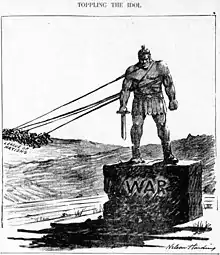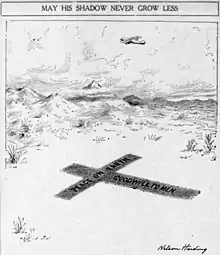Nelson Harding
Nelson Harding (October 31, 1879 – December 30, 1944) was an American editorial cartoonist for the Brooklyn Daily Eagle. He won the annual Pulitzer Prize for Editorial Cartooning in both 1927 and 1928, and as of 2020 was the only cartoonist so honored in consecutive years.[1] The cartoon that he won the Pulitzer Prize for in 1927 was called "Toppling The Idol" of which he depicted the "passive effect of the League of Nations" when dealing with the war. He used the images of David and Goliath.[2] The particular cartoon cited in 1928, "May His Shadow Never Grow Less", was a tribute drawn at the end of the 1927 calendar year to flier Charles Lindbergh,[3] it was for the flight across the Mexico America border to improve the relations between the two countries.[2] The Christmas-themed cartoon was published at the very end of 1927 and was eligible for Pulitzer consideration in 1928.[4]
Nelson Harding | |
|---|---|
 | |
| Born | October 31, 1879 Brooklyn, New York |
| Died | December 30, 1944 Veteran's Administration Hospital |
| Occupation | Cartoonist |
| Employer | The Brooklyn Daily Eagle |
| Known for | Pulitzer Prize for Editorial Cartooning |
| Signature | |
Harding was born in New York City. His work was often politically conservative by the standards of his day. He took a leading role in opposition to what some New Yorkers considered to be a threat from Bolshevism in the late 1910s, during the so-called First Red Scare. His cartoons portrayed political radicals as bomb-throwers and terrorists.[5]
Education
Harding attended Greenwich Academy (now an all girls school) as a child. He also attended The Chase School, the Art Students' League of New York and the New York School of Art for his training in art. While at the Chase school he was instructed by Robert Henri who was a master of his art.[6]
Career
In 1898 Harding served in the Spanish–American War with the U.S. Volunteers, he served 13 years in the National Guard 71st Battalion Company B. In 1901 he was promoted to Sargent under Major J.H. Wells.[6] Nelson Harding started working for the Brooklyn Daily Eagle in 1908 where he became a successful cartoonist.
Pulitzer Prizes
"Toppling the Idol"
For his cartoon that was published on September 19, 1926, Harding won the Pulitzer Prize for Editorial Cartooning in 1927 with his cartoon "Toppling the Idol."[7] It depicts a group representing the League of Nations dragging the statue of Mars (mythology) off its pedestal.
"May His Shadow Never Grow Less"
Published on December 15, 1927, the 1927 Pulitzer Prize for Editorial Cartooning winner depicts the Charles A. Lindbergh flight from New York to Paris in a single-engine plane. The religious symbol on the ground with the words "Peace on Earth and Goodwill to Men" was inspired by the approaching Christmas season.[7]
Gallery
 "Toppling the Idol", for which Harding received the 1927 Pulitzer Prize for Editorial Cartooning
"Toppling the Idol", for which Harding received the 1927 Pulitzer Prize for Editorial Cartooning "May His Shadow Never Grow Less", for which Harding received the 1928 Pulitzer Prize for Editorial Cartooning
"May His Shadow Never Grow Less", for which Harding received the 1928 Pulitzer Prize for Editorial Cartooning.jpg.webp) There Was An Old Man Who Lived in a Shoe
There Was An Old Man Who Lived in a Shoe.jpg.webp) Fooling With The Ouija Board (Nelson Harding)
Fooling With The Ouija Board (Nelson Harding)
References
- "Editorial Cartooning". The Pulitzer Prizes. Retrieved 2011-10-17.
- Harding, Nelson. "1927 Award about Conflict and Problem Solving in 1926 and 1927." Fischer, Heinz-Dietrich. Editorial Cartoon Awards 1922-1997. New York: Universal Press Syndicate and Sheed & Ward INC, 1999. 89-96. Book.
- "Education: Pulitzer Prizes". TIME. May 14, 1928. Retrieved 2011-10-17.
- "A Month of Pulitzer Prize Winning Cartoons - Day 22". CBR. 2009-03-23. Retrieved 2020-09-21.
- "Red Scare: Nelson Harding – Illustrator". Baruch College. Archived from the original on September 12, 2011. Retrieved 2011-10-17.
- Cooper, S. W. The Brooklyn Daily Eagle. 30 August 1925. Newspaper article. 25 October 2020.
- “5-6. Toppling the Idol.” The Lines Are Drawn: American Life since the First World War as Reflected in the Pulitzer Prize Cartoons, by Gerald W. Johnson, Lippincott, 1958, pp. 48–59.
External links
 Media related to Nelson Harding at Wikimedia Commons
Media related to Nelson Harding at Wikimedia Commons- Works by Nelson Harding at the Library of Congress
- Cooper, S. W. The Brooklyn Daily Eagle. 30 August 1925. Newspaper article. 25 October 2020 https://www.newspapers.com/image/58258794/?terms=nelson%20harding&match=1